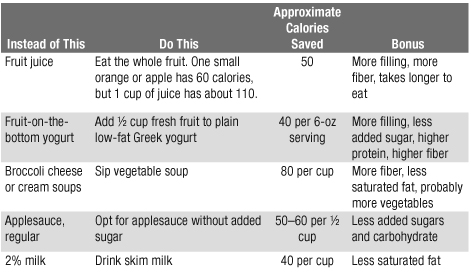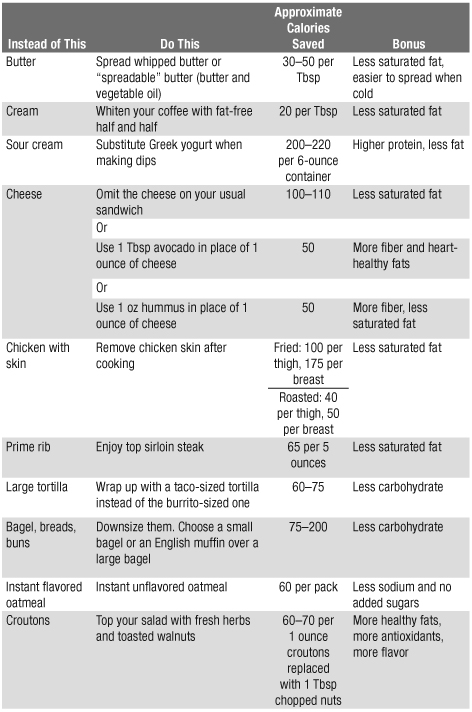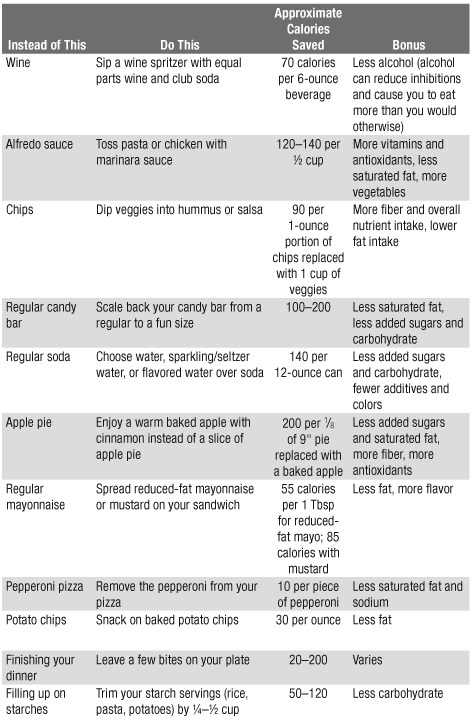
This chapter adds to the calorie-trimming tips and strategies that you’ve learned in previous weeks. You will also learn about adding strength training to your fitness plan and techniques to help you evaluate whether the goals you have chosen are suitable.
By now, you’ve practiced reading food labels for calories, carbohydrates, fats, and other things and you’ve found a few ways to cut back. Some strategies you might not have already considered are shown in the table below.



Knowing what to do isn’t the same as knowing how to do it or even wanting to do it. You may feel that it’s important to exercise or eat five servings of vegetables each day, but you just haven’t made those changes or some other desired changes yet. Sometimes when people aren’t successful, it’s simply because they chose the wrong goal. Is the goal too large? Does a family member or a doctor tell you it’s important, but you don’t think it is? There are a lot of reasons your goal might not be the right one for you today. You need to assess both your motivation to work toward your goal and your confidence in being able to achieve it. You are most likely to be successful if you have a moderate to high degree of both motivation and confidence.
Think about your SMART goal. Now look at the diagram below. What number represents your motivation to work on this goal? What number represents your confidence that you can achieve this SMART goal? If you don’t rank your confidence as 7 or more, then success may be difficult and you should probably revise your goal. If your motivation is high but your confidence is low, ask yourself why you chose this goal, whether you can achieve this goal at a lower level, what benefit you will gain by reaching this goal, and how important it is. The conversation you have with yourself may guide you to success.

In Week 1, you learned about the four components of physical fitness (aerobic, strength, flexibility, and balance), and you were encouraged to start some walking or other aerobic activity. This week, take some time to do at least a little strength-building exercise. Though you’ll sometimes hear people say that you should focus on aerobic activity to burn calories, strength training isn’t any less essential. Not only does building muscle increase your metabolic rate some (not a lot, but some), it also improves insulin resistance and helps you stay strong for your everyday activities. This becomes even more important as we age and naturally lose muscle mass. Remember, however, that if you have proliferative retinopathy (eye disease), you should not lift weights without the approval of an ophthalmologist.
You don’t have to join a gym to get started. Simple push-ups and sit-ups count. So does working with elastic stretch bands, which are available at sports and discount stores. You may, however, find that you enjoy your workouts and get more out of them if you go to a gym or work with a personal trainer to learn proper techniques. In their joint paper, the American Diabetes Association and the American College of Sports Medicine recommend performing 5–10 exercises that involve the upper body, lower body, and core for two to three sessions every week. Start out slowly and work up to this goal.
Set yourself up to be successful! That means not relying on willpower, but instead making plans and using skills. Willpower rarely lasts long, but skills and strategies are yours forever. Try a few of these tricks to create a perfect environment for winning at weight loss.
• Instead of keeping tempting foods in sight, “hide” them in hard-to-reach places like the back corner of the pantry or the high cabinet above the refrigerator. At the very least, store them in dark containers.
• Buy your family the treats that are easy for you to resist.
• Divide crackers, nuts, cereal, and other foods into healthy portions and put them in individual baggies or containers. Store the baggies in the original box.
• Make it a house rule to keep all junk food away from the home. Anyone who wants a treat can go to the store, ice cream shop, or bakery to buy a single serving.
• If there are foods in your refrigerator or pantry that you want to avoid, store them all on the same shelf. Let others in the house know what belongs there.
• Make snacking on fruits and veggies as easy as grabbing a bag of chips. Place washed cherries, grapes, carrots, cauliflower, and more at eye level in the refrigerator. Keep them in baggies to make them an easy grab-and-go snack.
• If you find yourself snacking all day, prepare limited and appropriate snacks first thing in the morning. At snack time, that’s all you have to choose from.
 I love ice cream, pies, and cakes, but I don’t keep them in the house anymore. If I don’t see it, I don’t have a hankering for it. I might eat some chocolates or something else when I visit my daughter, and sometimes when I go out, but that’s it. It’s easier to resist when it’s not staring me in the face.
I love ice cream, pies, and cakes, but I don’t keep them in the house anymore. If I don’t see it, I don’t have a hankering for it. I might eat some chocolates or something else when I visit my daughter, and sometimes when I go out, but that’s it. It’s easier to resist when it’s not staring me in the face. Continue the following goals: __________________________________________________________
Continue the following goals: __________________________________________________________